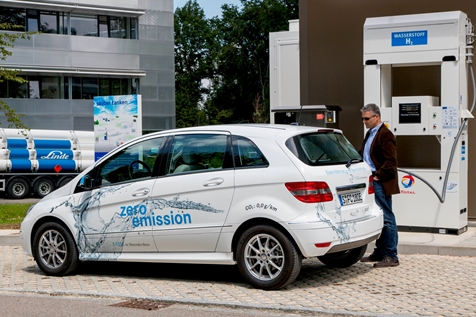Linde AG is among the companies that open new hydrogen fuel pump in Ulm

Photo by Linde AG
The network of hydrogen (H2) filling stations in Germany is growing: Daimler, Linde, Total, and the Centre for Solar Energy and Hydrogen Research Baden-Württemberg (ZSW) jointly hosted the official opening of another hydrogen fuel pump in Ulm. After openings at the Geiselwind motorway service area, at two locations in Berlin, and a station in Fellbach, Baden-Württemberg, the partners have now taken a further step towards a nationwide H2 supply network.
To date, 21 hydrogen filling stations have been completed in Germany. They are funded as research and development projects by the German federal government through the National Innovation Programme for Hydrogen and Fuel Cell Technology (NIP). The existing filling stations already reach some six million people in the metropolitan regions of Berlin, Hamburg, the Rhine/Ruhr, Stuttgart and Munich. Seven stations are located in Baden-Württemberg alone, with five more planned in the region.
Within the NIP expansion programme, Daimler and Linde are participating in a total of 20 new H2 stations with a total investment of around 20 million euros. Total operates the hydrogen pump in Ulm and paid for its construction.
Located on the grounds of ZSW on Helmholtzstrasse, the new station is part of the Clean Energy Partnership (CEP). Its official opening was attended by senior representatives of the companies involved, as well as representatives from the federal government and the Baden-Württemberg Environment Ministry.
Dr. Klaus Bonhoff, Managing Director of the National Organisation for Hydrogen and Fuel Cell Technology (NOW), said: “The system – from hydrogen production to refuelling, through to the customer’s vehicle – works. This is one of the most important results of the National Innovation Programme for Hydrogen and Fuel Cell Technology, which expires in its current form at the end 2016. As part of the Clean Energy Partnership, the federal government has invested more than 110 million euros of funding in testing the technology for its suitability for everyday use since 2008. Now, in a first expansion stage, 50 hydrogen filling stations are being built, jointly funded by government and industry. The filling station in Ulm, whose construction and operation the federal government is funding with close to a million euros, closes the Munich-Stuttgart corridor.”
Norbert Barthle, Parliamentary State Secretary at the Federal Ministry of Transport and Digital Infrastructure, commented: “The market ramp-up of electric cars is beginning, and the vehicle manufacturers’ offers are becoming more varied and attractive. To get e-cars onto the road, we now need an extensive network of H2 filling stations in Germany – in the cities, along the autobahns and also in more rural areas. The establishment of the station in Ulm is another important component in this.”
The technical maturity of fuel-cell vehicles is now beyond question, and the benefits of the technology are obvious: a long range, quick refuelling times and a wide range of possible applications, from cars to city buses. Daimler AG has focused on fuel cells alongside battery-powered electric drives from the start. Electric vehicles with fuel cells are locally just as emissions-free as battery-powered vehicles, but have a much greater range and shorter refuelling time.
“Following the success of the Mercedes-Benz B-Class F-CELL, a new generation of vehicles based on our GLC will launch from 2017. For the first time in an electric fuel-cell vehicle, a lithium-ion battery will be used as an independent drive mode. So in the next step our fuel cell will be getting a plug,” said Professor Dr. Christian Mohrdieck, Head of Fuel Cells at Daimler AG. “In view of the market launch, the rapid development of infrastructure is a top priority. We are proud to be able to make an important contribution to this, not least as part of the H2 Mobility joint venture.”
“In arithmetical terms, the hydrogen fuelling capacity currently installed in Germany can already accommodate more than 8,000 fuel cell vehicles,” said Dr. Dieter Prangenberg, responsible for the Southern sales region at Linde. “Three quarters of German H2 service stations are equipped with Linde technology, as is the one in Ulm.”
Guillaume Larroque, Director of Service Stations at Total Deutschland GmbH, said: “We’ve been investing in hydrogen mobility research and development since 2002. Initially our efforts centred on defining common standards for tank technology together with our partners. As a leading player in the network expansion, Total alone operates nine of Germany’s 21 public H2 stations!”
For more information, please visit http://www.linde.de.
News Categories
- » NEWS HOME
- » Automation & Robotics
- » Industry 4.0
- » Material Handling
- » Sensors
- » Quality & Testing
- » Machine Vision
- » Laser & Optics
- » Metalworking
- » Motion Control & Drives
- » Hydraulics & Pneumatics
- » Process Industry
- » Renewable Energy
- » Agriculture
- » Home & Office Furniture
- » Environmental Tech



